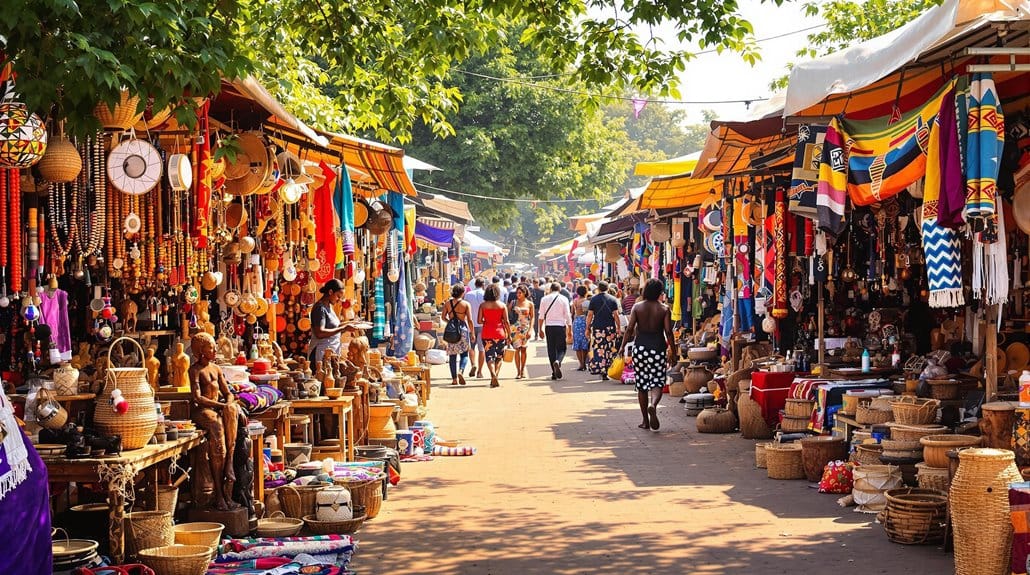When you think about traditional African crafts, a world of vibrant textiles, intricate beadwork, and unique wood carvings comes to mind. Each piece tells a story, reflecting the rich cultural heritage of the continent. You might be surprised by the variety of artisan markets, like the bustling Maasai Market or the historic souks of Marrakech, where these crafts come to life. As you explore these enchanting traditions, you'll discover not just art, but the deeper connections they foster within communities. What secrets might these markets hold for those willing to engage with their artistry?
Key Takeaways
- Kente cloth from Ghana is renowned for its vibrant colors and intricate designs, symbolizing cultural narratives and traditions.
- Maasai beadwork from Kenya features colorful jewelry with deep symbolism, showcasing local identities and enhancing artisans' livelihoods.
- Bamileke stools from Cameroon represent social status through intricate wood carvings, reflecting community beliefs and artistic depth.
- San pottery from Southern Africa utilizes traditional coiling methods, while Xhosa pottery from South Africa is known for its bright colors.
- The Maasai Market in Nairobi and the Souks of Marrakech are vibrant hubs for authentic crafts, offering cultural experiences and supporting local artisans.
Traditional Textiles of Africa
When you explore the world of traditional textiles in Africa, you'll encounter a rich tapestry of vibrant colors and intricate patterns that tell the stories of diverse cultures. Each piece of African textile is like a living document, reflecting historical narratives and communal identities.
Take Kente cloth from Ghana, for instance; its elaborate designs and bright colors are woven using techniques passed down through generations, embodying the essence of traditional African art.
Kuba cloth from the Democratic Republic of Congo, valued for its durability and quality, showcases the artistry of Kuba women since the 15th century, a reflection of their craftsmanship. These textiles aren't just fabric; they play vital roles in ceremonies, where specific patterns symbolize cultural meanings and social statuses.
As you engage with these textiles, you'll discover that they're not merely decorative; they're integral to the communities they represent. The growing global interest in African textiles promotes economic growth, allowing artisans to thrive in both local and international markets.
Intricate Beadwork Techniques
Celebrating the artistry of intricate beadwork techniques reveals a vibrant world where each bead tells a story. Across Africa, these artistic traditions aren't just craft but a means of cultural expression.
The Maasai of Kenya exemplify this with their colorful jewelry, rich in symbolism and narrative, while Nigeria's beadwork showcases unique patterns that reflect local identities and social status.
As you explore these techniques, consider the diverse materials artisans use, such as glass, clay, and seeds. This creativity finds its way into various items, from accessories to ceremonial decorations, enhancing the tapestry of African culture.
- Cooperative groups in Kenya and Uganda empower artisans, fostering skills and improving livelihoods.
- Global tourism has driven demand for authentic African beadwork, bringing newfound attention to these crafts.
- Craft fairs and exhibitions provide platforms for artisans, allowing their stories to resonate with a wider audience.
Unique Wood Carvings
The artistry of unique wood carvings stands as a tribute to Africa's rich cultural heritage, much like the intricate beadwork that precedes it. In regions like Cameroon, the Bamileke stools are more than mere furniture; they symbolize social status and the deep cultural narratives of their makers.
Artisans carve local hardwoods into stunning sculptures and functional items, showcasing animals, human figures, and symbols that encapsulate community beliefs and traditions. Each tribe boasts its distinct style, such as the Baule people's beaded masks from Côte d'Ivoire, celebrated for their artistic depth.
When you visit markets in Kenya or Tanzania, you're stepping into vibrant hubs alive with the energy of wood carvings. Here, both locals and international tourists seek authentic pieces, creating connections with the artisans who bring these works to life.
The economic impact of this craft is profound. By participating in local and international markets, artisans not only sustain their livelihoods but also guarantee that the stories of their culture are passed on.
As you explore these unique wood carvings, you're not just acquiring art; you're embracing a piece of West African heritage.
Vibrant Pottery Styles
African pottery styles showcase a remarkable diversity, with each region contributing its own unique techniques and aesthetics. When you explore these vibrant creations, you'll find that they reflect cultural practices and historical significance.
For instance, the San people in Southern Africa employ a traditional coiling method, while the intricate designs of the Mangbetu culture in the Democratic Republic of Congo stand out for their artistic finesse.
- The Nok culture in Nigeria has left a legacy with its terracotta sculptures dating back to 1000 BCE.
- Xhosa pottery from South Africa captivates with bright colors and intricate patterns, often used in cultural ceremonies.
- Ghanaian pottery, especially from the Volta Region, features unique forms and textures, embellished with natural pigments.
Each piece tells a story, connecting you to the community and its heritage. As you admire these works, you'll notice how they often incorporate elements of African fabric, further enriching their cultural context.
Artisan Markets and Cultural Hubs
Exploring the vibrant tapestry of traditional crafts naturally leads you to the artisan markets and cultural hubs that serve as their lifeblood. These bustling spaces are where local artisans showcase their skills, offering you a better understanding of their heritage and creativity. Markets like the Maasai Market in Nairobi and the Souks of Marrakech are more than just shopping spots; they're cultural experiences that connect you to the heart of African traditions.
Here's a glance at some notable artisan markets across Africa:
| Market Name | Location | Specialties |
|---|---|---|
| Maasai Market | Nairobi, Kenya | Beadwork, textiles |
| Souks of Marrakech | Marrakech, Morocco | Pottery, leather goods |
| Neighbourgoods Market | Johannesburg, South Africa | Zulu beadwork, crafts |
| Kente Festival | Ghana | Traditional weaving |
| 1:54 Art Fair | Various locations | Contemporary and traditional art |
These markets foster community, amplify artisans' voices, and attract both locals and tourists. By immersing yourself in these vibrant atmospheres, you not only discover unique crafts but also forge connections that celebrate cultural diversity.
Frequently Asked Questions
What Is a Traditional African Craft?
A traditional African craft is a vibrant expression of cultural heritage, showcasing intricate beadwork techniques and stunning textile patterns.
You'll find these crafts not only serve practical purposes, like storage or clothing, but also embody the spirit of community and history.
Each piece tells a story, often reflecting the unique identity of its maker. Engaging with these crafts connects you to their rich traditions, making you feel part of something much larger than yourself.
What Is the Most Popular African Art?
When you explore African artistry, you'll find that the most popular forms often embody rich cultural expression.
Textiles like Kente cloth, known for their vibrant patterns, tell stories of heritage and identity.
Intricate beadwork and wood carvings reveal deep connections to ancestral traditions.
Each piece resonates with a sense of belonging, inviting you to appreciate the craftsmanship and history behind these art forms, making them cherished by both locals and global enthusiasts.
What Are African American Traditional Crafts?
African American traditional crafts showcase rich African artistry and cultural heritage, reflecting deep community connections.
You'll find quilting that tells stories through intricate patterns, basket weaving that combines practicality and symbolism, and pottery that celebrates historical techniques.
Each craft carries the weight of tradition, inviting you to connect with a vibrant history.
Engaging with these crafts not only honors ancestors but also fosters a sense of belonging within a diverse cultural landscape.
What Is Africa Famous for Making?
Africa's renowned for its rich craftsmanship, especially in African textiles and intricate beadwork techniques.
When you explore these creations, you'll find vibrant patterns in Kente cloth that tell stories, and colorful Maasai jewelry that reflects cultural significance.
Each item embodies the spirit of its community, making you feel connected to a broader heritage.
The artistry not only showcases skill but also fosters a sense of belonging that resonates deeply within you and others.
Conclusion
In exploring Africa's rich tapestry of crafts, you've uncovered vibrant stories woven into Kente cloth, intricate beadwork, unique wood carvings, and exquisite pottery. Each piece isn't just a craft; it's a living representation of cultural heritage and creativity. So, why not immerse yourself in these artisan markets? They're not just places to shop; they're gateways to experience the soul of Africa. By engaging with these traditions, you're not merely an observer—you become part of a timeless narrative.








